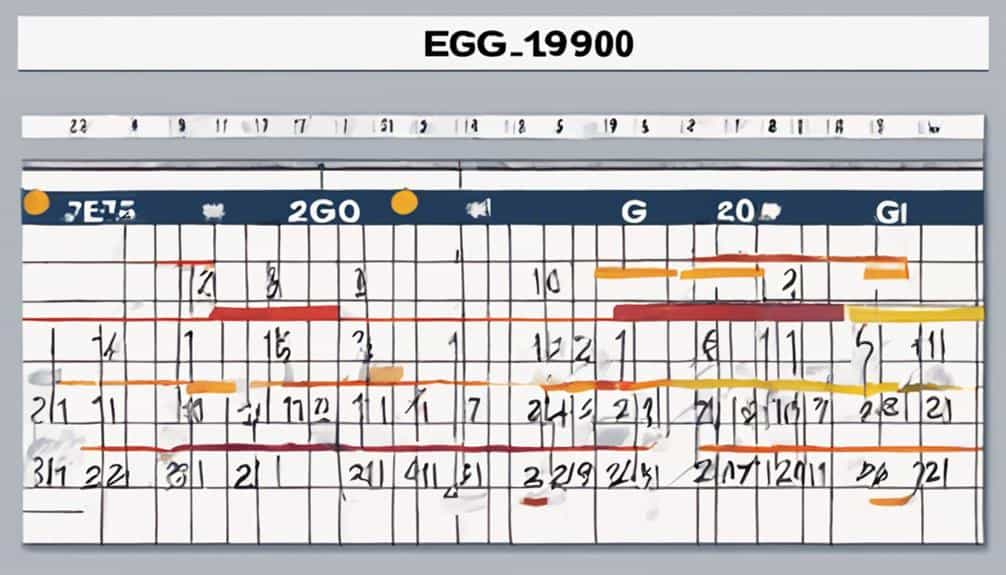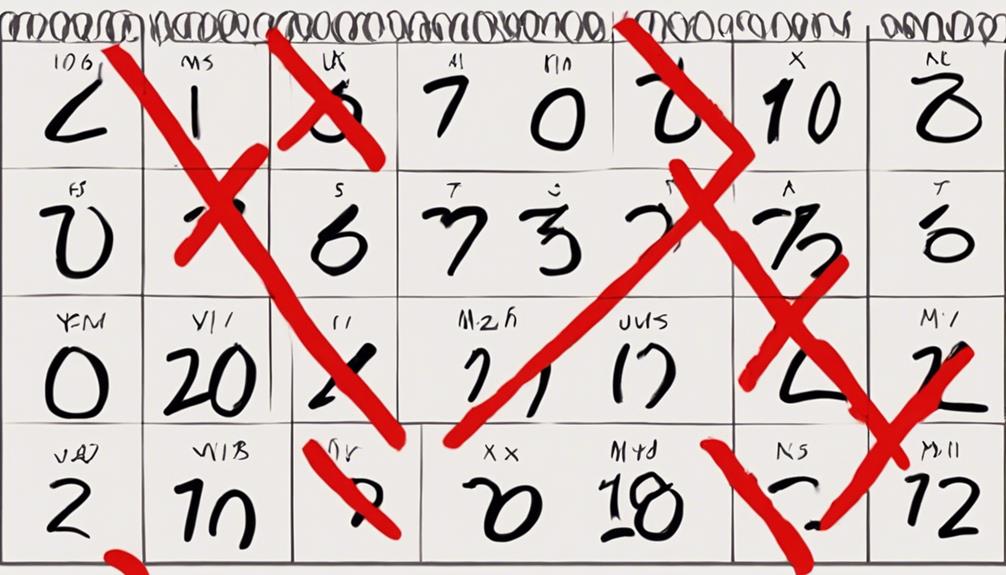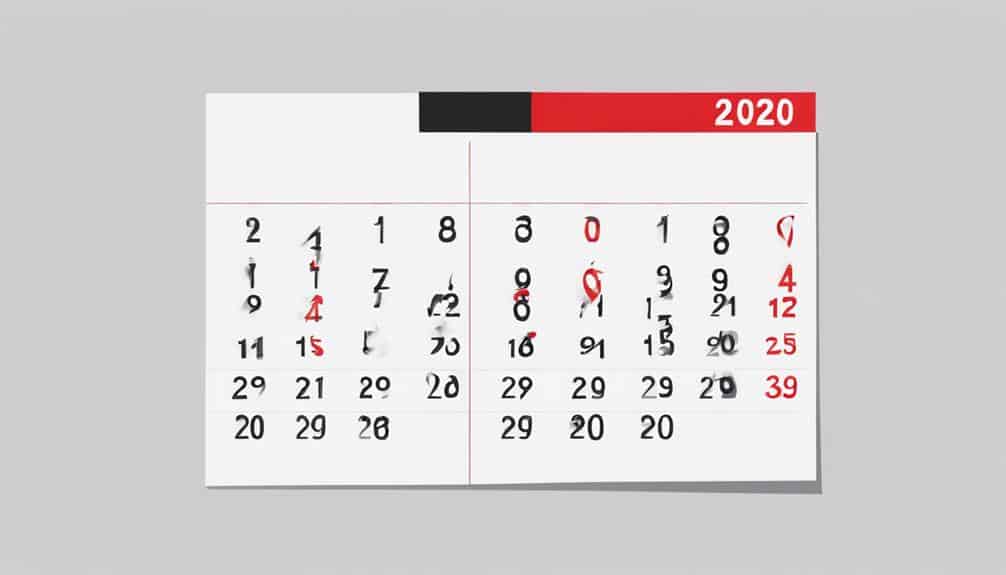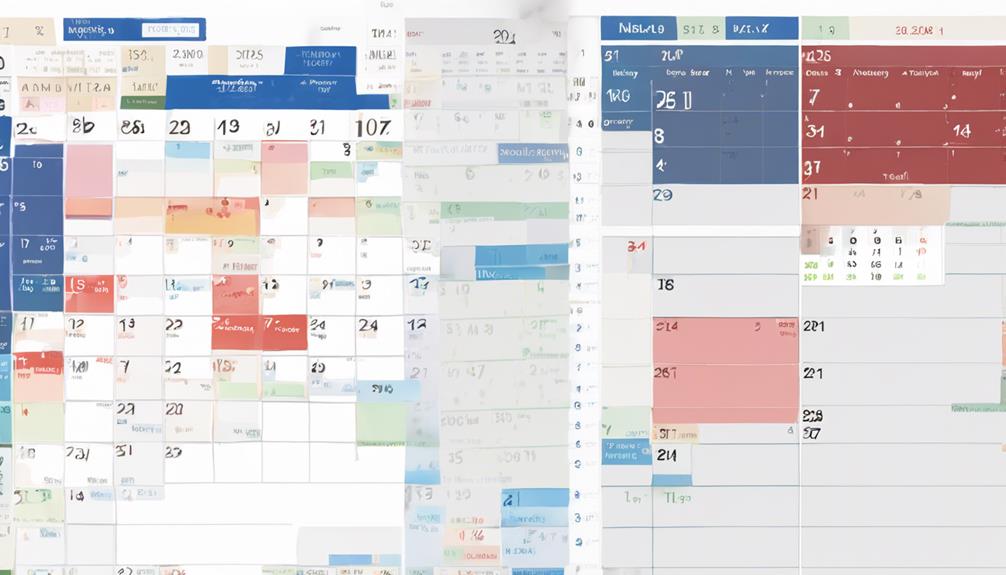To abbreviate a year correctly, use an apostrophe to replace missing numbers. Guarantee clarity and consistency in your writing by placing the apostrophe before the last two digits of a year. This applies to specific years and decades, so be consistent in your formatting. For year ranges, use an en dash to connect the dates. Remember, consistency is key to maintaining professionalism in your writing. By mastering year abbreviation, you'll take your writing to the next level – and there's more to explore to take your skills even further.
Key Takeaways
• Use an apostrophe to replace missing numbers in year abbreviations, ensuring clarity and consistency in writing.
• Place the apostrophe before the last two digits of a year, such as '20 for the year 2020.
• Abbreviate decades, like '20s or '90s, for concise writing and maintain consistency throughout.
• Use en dashes to connect year ranges, such as 2010–2015, for proper punctuation and readability.
• Ensure consistency in year abbreviation, as misplacing apostrophes can lead to confusion and affect professionalism.
Abbreviating Years Correctly
When abbreviating a year, always use an apostrophe to replace the missing numbers, ensuring clarity and consistency in your writing. This rule applies whether you're writing in a formal or informal setting, including academic papers, news articles, or even social media posts.
For instance, if you're referring to the year 1998, you can shorten it to '98. This notation is widely accepted and understood, making it easier for readers to comprehend your content. Remember, consistency is key when abbreviating years. Decide on a style and stick to it throughout your writing.
You can also use this notation when referring to decades, such as the '80s for the 1980s. If you're writing a book or creating content for a global audience, consider adding a disclaimer, like 'All rights reserved, New York.'
Apostrophe Usage Explained

When delving into the world of abbreviating years, understanding the rules of apostrophe placement is crucial to avoid confusion.
You'll learn how to correctly place the apostrophe to shorten years, ensuring clarity and professionalism in your writing.
Let's break down the rules and examples to master year abbreviation with apostrophes.
Apostrophe Placement Rules
You'll often find that placing an apostrophe before the last two digits of a year is essential in maintaining clarity and consistency when abbreviating dates in writing. This rule applies not only to specific years but also to decades.
In the United States, for instance, you might see references to the '80s or the '90s, where the apostrophe takes the place of the first two digits.
Here are some key points to keep in mind when using apostrophes in abbreviating years:
- Use an apostrophe before the last two digits: This is the standard way to abbreviate a year, as in '98 for 1998.
- Decades can also be shortened: You can use an apostrophe to shorten a decade, like the '80s for the 1980s.
- Consistency is key: Make sure to use the apostrophe consistently throughout your writing to maintain clarity and avoid confusion.
Year Abbreviation Examples
By applying the apostrophe rule, you can effectively shorten years, such as converting 1995 to '95, and decades, like the 1980s to the '80s. This technique helps you save space and streamline your writing.
For instance, instead of writing 'the 2000s,' you can simply write 'the '00s.' This abbreviation isn't only concise but also easy to read.
When using apostrophes to abbreviate years, consistency is key. Make sure that you use the same format throughout your writing to maintain clarity and professionalism.
For example, if you're writing about a series of events that occurred in the '60s, '70s, and '80s, using the apostrophe consistently will create a cohesive and polished piece of writing.
Writing Years in Ranges

When writing years in ranges, you'll encounter situations where you need to shorten the years while maintaining clarity.
You'll learn how to handle years with common digits and when to drop unnecessary digits, making your writing more concise and effective.
Years With Common Digits
Abbreviate years with common digits by using an apostrophe before the last two digits, and connect ranges of years with an en dash, as in '09 for 2009 and 2010–2015 for the years between 2010 and 2015.
When writing years in ranges, consistency is key to maintaining clarity and professionalism. Correctly formatting years in ranges enhances the readability and organization of written content.
Here are three essential tips to keep in mind:
- Use an apostrophe: Add an apostrophe before the last two digits of a year to abbreviate it, like '09 for 2009.
- Connect ranges with an en dash: Use an en dash (–) without spaces to connect ranges of years, such as 2010–2015.
- Be consistent: Maintain consistency in formatting years in ranges to ensure clarity and professionalism.
Dropping Unnecessary Digits
To clarify the years in a range, drop unnecessary digits and use an en dash to separate the start and end years, making your writing more concise and easier to read.
This technique is especially useful when expressing a range of years, like 2000–2008. By dropping the redundant digits, you're left with a more streamlined and efficient way of presenting the information.
When using this method, remember to employ an en dash (–) instead of a hyphen (-). The en dash symbolizes a span or range, which is essential for clarity and proper punctuation in written content.
For instance, 'The study covered 2005–2010' is correct, whereas 'The study covered 2005-2010' is incorrect.
Incorporating Dates in Text

Incorporating dates into your writing is crucial, whether you're citing a specific event, referencing a historical occurrence, or simply providing context for your audience. When doing so, maintaining consistency and clarity is vital.
Here are three key considerations to keep in mind:
- Format dates correctly: Use the month-day-year format (April 22, 2017) in American English and the day-month-year format (22 April 2017) in British English.
- Abbreviate months consistently: Use abbreviations like Jan., Feb., and Mar. to uphold consistency throughout your writing.
- Use en dashes for date ranges: When writing a range of years, use an en dash (–) instead of a hyphen, like this: 1997–2006.
Common Abbreviation Mistakes

When incorporating dates into your writing, it's easy to overlook small mistakes that can have a substantial impact on clarity, but common abbreviation errors can be avoided by understanding the nuances of shortened years.
Here are some common mistakes to watch out for:
| Incorrect | Correct |
|---|---|
| '12 | '12 |
| the '90s | the '90s |
| '90s | '90s |
As you can see, misplacing apostrophes or using quotation marks instead of apostrophes can lead to confusion. Understanding the difference between an apostrophe and a quotation mark is important to avoid errors in abbreviation. Remember, consistency in abbreviating years with apostrophes is key to maintaining accuracy and readability. By being mindful of these common mistakes, you can make sure that your writing is clear, concise, and professional.
Year Ranges and Hyphens

Incorporating accurate punctuation when expressing year ranges is essential for maintaining clarity in your writing. It guarantees that your message is conveyed accurately and efficiently.
When it comes to year ranges, a small mistake can lead to confusion. That's why it's important to use the correct punctuation.
Here are three key takeaways to keep in mind:
- Use an en dash (–) when indicating a range of years, such as 2010–2015.
- Avoid using a hyphen (-) for year ranges as it can cause confusion.
- Consistency is key: using en dashes for year ranges maintains professionalism in your written content.
Best Practices for Clarity

By following a few simple guidelines, you can guarantee that your abbreviated years are clear and unambiguous, making your writing more effective and efficient.
To maintain clarity, it's important to be consistent in your abbreviations. For instance, if you're using '09 for 2009, stick to that format throughout your writing. This consistency will help your readers quickly grasp the intended year.
When abbreviating years, use an apostrophe before the last two digits, such as '98 for 1998. This ensures that your readers can easily decipher the intended year. Additionally, consider using 'yrs.' to shorten the word 'years' and 'yr' for a singular year in quick notes, like '6 yr report' for a 6-year report.
Remember to use an apostrophe and an 's' when abbreviating a decade, like the '80s for the 1980s.
Lastly, don't forget to ensure correct punctuation by hitting the apostrophe key twice and then deleting the first apostrophe when abbreviating years. By following these best practices, you'll be able to effectively convey your intended years, making your writing more concise and efficient.
Using Abbreviations in Titles

To effectively convey dates in titles, you'll want to strategically use abbreviations to save space and create a concise format. When using abbreviations in titles, remember to maintain consistency to guarantee clarity and professionalism.
Here are some key considerations to keep in mind:
- Use an apostrophe: Always use an apostrophe before the shortened year to indicate the omission of digits, such as '21 for the year 2021.
- Decade abbreviations: Use abbreviations like '20s or '90s to refer to entire decades in titles, saving space and creating a concise format.
- Shorten years: Use abbreviations like '12 or '99 in titles to save space and create a concise format.
Consistency in Date Formatting

When you're working with dates in titles, maintaining consistency in formatting is important to guarantee clarity and professionalism throughout your writing.
You can't afford to confuse your readers with inconsistent date formats, so it's necessary to choose a format and stick to it. Decide on either the American (month/day/year) or British (day/month/year) format and use it consistently throughout your document.
Remember to abbreviate months (e.g., Jan, Feb, Mar) to create a professional look. When indicating year ranges, use en dashes (e.g., 2020–2022) for a clean and concise presentation.
Avoid mixing abbreviated and written-out dates within the same document, as it can create confusion.
Proper punctuation and formatting are important to enhancing the readability and professionalism of your writing. By maintaining consistency in date formatting, you'll ensure that your writing is clear, concise, and easy to understand.
Frequently Asked Questions
How to Properly Abbreviate a Year?
You're trying to abbreviate a year like a pro, and it's as smooth as buttering toast! To get it right, remember that an apostrophe before the last two digits is key, like '98 for 1998.
Be consistent, and you'll avoid confusion. Don't forget to add an apostrophe and an 's' for decades, like the '80s.
Keep punctuation and spacing on point, and you'll be abbreviating like a master in no time!
Do You Put an Apostrophe After a Year?
You're wondering if you put an apostrophe after a year? The answer is no, you don't. Instead, you place it before the last two digits.
For example, '09 for 2009. This rule applies to decades too, like '90s for the 1990s. By following this convention, you'll maintain clarity and consistency in your writing.
What Is the Acronym for a Year?
As you navigate the timeline of years, you'll find yourself asking, 'what's the acronym for a year?'
The answer is simple: take the last two digits and add an apostrophe before them. For instance, '98 stands for 1998, and '10 represents 2010.
This shorthand saves space and time, making it a convenient way to refer to specific periods. By using this method, you'll be concise and clear in your written communication.
How Do You Abbreviate the 12 Months of the Year?
When you need to abbreviate the 12 months of the year, you'll want to use standardized shortcuts.
You'll use Jan. for January, Feb. for February, and so on.
For the rest, it's Mar. for March, Apr. for April, May for May, Jun. for June, Jul. for July, Aug. for August, Sep. for September, Oct. for October, Nov. for November, and Dec. for December.
Using these consistent abbreviations will make your writing clear and efficient.



